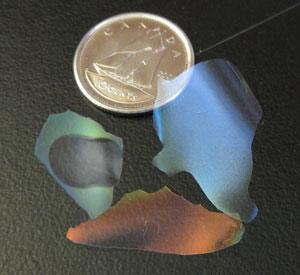Colour-tuneable silica films using a cheap chiral template material
Using nanocrystalline cellulose (NCC) from wood pulp, Canadian researchers have for the first time prepared mesoporous chiral nematic structured silica materials that may have potential as tuneable reflective filters in smart windows, chiral catalysts in synthesis and even as optical sensing devices.
A team led by Mark MacLachlan at the University of British Columbia in Vancouver, used an aqueous solution of NCC with silica precursors and found that in a narrow pH range they formed chiral structures with pore diameters in the range of 4 to 5nm and which are organised in a helical thread-like form.1
Mesoporous silica materials have been prepared before but attaining chirality has been a difficult task. ’Others tried it before but it turns out that the pH range over which these structures are formed without any disruption is very narrow,’ says MacLachlan. These structures are chiral because of the sugar chains of cellulose that form the pores.

Viveka Alfredsson is based at Lund University in Sweden and works on the formation of mesoporous silica materials and its functional derivatives. She says, ’It is good to see cheap and widely available cellulose being used to make chiral mesoporous silica. Other chiral mesoporous silica structures have been made - for example by Shunai Che from Shanghai Jiao Tong University in China - but by using quite expensive chiral surfactants.’2
The material is also porous, and filling up the pores with water makes the structure completely transparent. This happens because the refractive index of water is very close to that of SiO2 and the differences are invisible to the naked eye.
The materials also possess impressive photonic properties. ’The origin of colour in the material is really interesting,’ says MacLachlan. ’The material selectively reflects the wavelength of light that matches the helical pitch of the pore.’ So by varying how steeply the pore spirals in the material, it can be made to reflect different colours.
This means that materials can be made that they are transparent to visible light but reflect infrared light, which could be used to coat windows and help stop heat leaking out of buildings.
The team is now looking at ways to use the silica template for building chiral nematic semiconductors and chiral catalysts.
Akshat Rathi
References
et al, Nature2010Adv. Funct. Mater20, 2750-2768 (DOI: 10.1002/adfm.201000074)






No comments yet